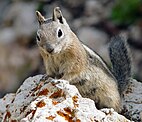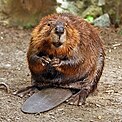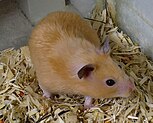Rodent
| Rodent Temporal range:
| |
|---|---|
| Scientific classification | |
| Domain: | Eukaryota |
| Kingdom: | Animalia |
| Phylum: | Chordata |
| Class: | Mammalia |
| Mirorder: | Simplicidentata |
| Order: | Rodentia Bowdich, 1821 |
| Suborders | |

| |
| Combined range of all rodent species (not including introduced populations) | |
Rodents (from
Rodents are extremely diverse in their ecology and lifestyles and can be found in almost every terrestrial habitat, including human-made environments. Species can be
Most rodents are small animals with robust bodies, short limbs, and long tails. They use their sharp incisors to gnaw food, excavate burrows, and defend themselves. Most eat seeds or other plant material, but some have more varied diets. They tend to be social animals and many species live in societies with complex ways of communicating with each other. Mating among rodents can vary from
The rodent fossil record dates back to the Paleocene on the supercontinent of Laurasia. Rodents greatly diversified in the Eocene, as they spread across continents, sometimes even crossing oceans. Rodents reached both South America and Madagascar from Africa and, until the arrival of Homo sapiens, were the only terrestrial placental mammals to reach and colonize Australia.
Rodents have been used as food, for clothing, as pets, and as laboratory animals in research. Some species, in particular, the brown rat, the black rat, and the house mouse, are serious pests, eating and spoiling food stored by humans and spreading diseases. Accidentally introduced species of rodents are often considered to be invasive and have caused the extinction of numerous species, such as island birds, the dodo being an example, previously isolated from land-based predators.
Characteristics

The distinguishing feature of the rodents is their pairs of continuously growing, razor-sharp, open-rooted incisors.[2] These incisors have thick layers of enamel on the front and little enamel on the back.[3] Because they do not stop growing, the animal must continue to wear them down so that they do not reach and pierce the skull. As the incisors grind against each other, the softer dentine on the rear of the teeth wears away, leaving the sharp enamel edge shaped like the blade of a chisel.[4] Most species have up to 22 teeth with no canines or anterior premolars. A gap, or diastema, occurs between the incisors and the cheek teeth in most species. This allows rodents to suck in their cheeks or lips to shield their mouth and throat from wood shavings and other inedible material, discarding this waste from the sides of their mouths.[citation needed] Chinchillas and guinea pigs have a high-fiber diet; their molars have no roots and grow continuously like their incisors.[5]
In many species, the molars are relatively large, intricately structured, and highly cusped or ridged. Rodent molars are well equipped to grind food into small particles.[2] The jaw musculature is strong. The lower jaw is thrust forward while gnawing and is pulled backwards during chewing.[3] Gnawing uses incisors and chewing uses molars, however, due to the cranial anatomy of rodents these feeding methods cannot be used at the same time and are considered to be mutually exclusive.[6] Among rodents, the masseter muscle plays a key role in chewing, making up 60% – 80% of the total muscle mass among masticatory muscles and reflects rodents' herbivorous diet.[7] Rodent groups differ in the arrangement of the jaw muscles and associated skull structures, both from other mammals and amongst themselves.
The
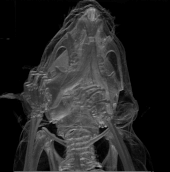
While the largest species, the

Rodents generally have well-developed senses of
Distribution and habitat
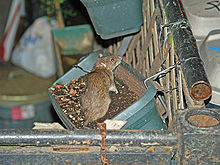
One of the most widespread groups of mammals, rodents can be found on every continent except Antarctica. They are the only terrestrial placental mammals to have colonized Australia and New Guinea without human intervention. Humans have also allowed the animals to spread to many remote oceanic islands (e.g., the Polynesian rat).[4] Rodents have adapted to almost every terrestrial habitat, from cold tundra (where they can live under snow) to hot deserts.
Some species such as tree squirrels and New World porcupines are arboreal, while some, such as gophers, tuco-tucos, and mole rats, live almost completely underground, where they build complex burrow systems. Others dwell on the surface of the ground, but may have a burrow into which they can retreat. Beavers and muskrats are known for being semiaquatic,[2] but the rodent best adapted for aquatic life is probably the earless water rat from New Guinea.[21] Rodents have also thrived in human-created environments such as agricultural and urban areas.[22]
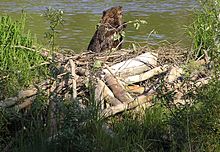
Though some species are common pests for humans, rodents also play important ecological roles.[2] Some rodents are considered keystone species and ecosystem engineers in their respective habitats. In the Great Plains of North America, the burrowing activities of prairie dogs play important roles in soil aeration and nutrient redistribution, raising the organic content of the soil and increasing the absorption of water. They maintain these grassland habitats,[23] and some large herbivores such as bison and pronghorn prefer to graze near prairie dog colonies due to the increased nutritional quality of forage.[24]
Extirpation of prairie dogs can also contribute to regional and local
In many temperate regions, beavers play an essential
Behavior and life history
Feeding

Most rodents are
The
Agouti species are one of the few animal groups that can break open the large capsules of the Brazil nut fruit. Too many seeds are inside to be consumed in one meal, so the agouti carries some off and caches them. This helps dispersal of the seeds as any that the agouti fails to retrieve are distant from the parent tree when they germinate. Other nut-bearing trees tend to bear a glut of fruits in the autumn. These are too numerous to be eaten in one meal and squirrels gather and store the surplus in crevices and hollow trees. In desert regions, seeds are often available only for short periods. The kangaroo rat collects all it can find and stores them in larder chambers in its burrow.[33]
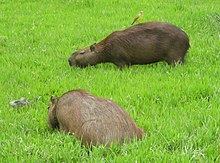
A strategy for dealing with seasonal plenty is to eat as much as possible and store the surplus nutrients as fat. Marmots do this, and may be 50% heavier in the autumn than in the spring. They rely on their fat reserves during their long winter hibernation.[33] Beavers feed on the leaves, buds, and inner bark of growing trees, as well as aquatic plants. They store food for winter use by felling small trees and leafy branches in the autumn and immersing them in their pond, sticking the ends into the mud to anchor them. Here, they can access their food supply underwater even when their pond is frozen over.[34]
Although rodents have been regarded traditionally as herbivores, most small rodents opportunistically include insects, worms, fungi, fish, or meat in their diets and a few have become specialized to rely on a diet of animal matter. A functional-morphological study of the rodent tooth system supports the idea that primitive rodents were omnivores rather than herbivores. Studies of the literature show that numerous members of the Sciuromorpha and Myomorpha, and a few members of the Hystricomorpha, have either included animal matter in their diets or been prepared to eat such food when offered it in captivity. Examination of the stomach contents of the North American white-footed mouse, normally considered to be herbivorous, showed 34% animal matter.[35]
More specialized carnivores include the
Social behavior

Rodents exhibit a wide range of types of social behavior ranging from the mammalian
Larger rodents tend to live in family units where parents and their offspring live together until the young disperse.
Among the most social of rodents are the ground squirrels, which typically form colonies based on female kinship, with males dispersing after weaning and becoming nomadic as adults. Cooperation in ground squirrels varies between species and typically includes making alarm calls, defending territories, sharing food, protecting nesting areas, and preventing infanticide.[44] The black-tailed prairie dog forms large towns that may cover many hectares. The burrows do not interconnect, but are excavated and occupied by territorial family groups known as coteries. A coterie often consists of an adult male, three or four adult females, several nonbreeding yearlings, and the current year's offspring. Individuals within coteries are friendly with each other, but hostile towards outsiders.[39]
Perhaps the most extreme examples of colonial behavior in rodents are the
Communication
Olfactory

Rodents use scent marking in many social contexts including inter- and intra-species communication, the marking of trails and the establishment of territories. Their urine provides genetic information about individuals including the species, the sex and individual identity, and metabolic information on dominance, reproductive status and health. Compounds derived from the major histocompatibility complex (MHC) are bound to several urinary proteins. The odor of a predator depresses scent-marking behavior.[46]
Rodents are able to recognize close relatives by smell and this allows them to show
House mice deposit urine, which contains pheromones, for territorial marking, individual and group recognition, and social organization.[48] Territorial beavers and red squirrels investigate and become familiar with the scents of their neighbors and respond less aggressively to intrusions by them than to those made by non-territorial "floaters" or strangers. This is known as the "dear enemy effect".[49][50]
Auditory

Many rodent species, particularly those that are diurnal and social, have a wide range of alarm calls that are emitted when they perceive threats. There are both direct and indirect benefits of doing this. A potential predator may stop when it knows it has been detected, or an alarm call can allow
Social rodents have a wider range of vocalizations than do solitary species. Fifteen different call-types have been recognized in adult Kataba mole rats and four in juveniles.[54] Similarly, the common degu, another social, burrowing rodent, exhibits a wide array of communication methods and has an elaborate vocal repertoire comprising fifteen different categories of sound.[55] Ultrasonic calls play a part in social communication between dormice and are used when the individuals are out of sight of each other.[56]
House mice use both audible and ultrasonic calls in a variety of contexts. Audible vocalizations can often be heard during agonistic or aggressive encounters, whereas ultrasound is used in sexual communication and also by pups when they have fallen out of the nest.[48]
Laboratory rats (which are brown rats, Rattus norvegicus) emit short, high frequency, ultrasonic vocalizations during purportedly pleasurable experiences such as rough-and-tumble play, when anticipating routine doses of morphine, during mating, and when tickled. The vocalization, described as a distinct "chirping", has been likened to laughter, and is interpreted as an expectation of something rewarding. In clinical studies, the chirping is associated with positive emotional feelings, and social bonding occurs with the tickler, resulting in the rats becoming conditioned to seek the tickling. However, as the rats age, the tendency to chirp declines. Like most rat vocalizations, the chirping is at frequencies too high for humans to hear without special equipment, so bat detectors have been used for this purpose.[57]
Visual
Rodents, like all placental mammals except primates, have just two types of light receptive cones in their retina,[58] a short wavelength "blue-UV" type and a middle wavelength "green" type. They are therefore classified as dichromats; however, they are visually sensitive into the ultraviolet (UV) spectrum and therefore can see light that humans can not. The functions of this UV sensitivity are not always clear. In degus, for example, the belly reflects more UV light than the back. Therefore, when a degu stands up on its hind legs, which it does when alarmed, it exposes its belly to other degus and ultraviolet vision may serve a purpose in communicating the alarm. When it stands on all fours, its low UV-reflectance back could help make the degu less visible to predators.[59] Ultraviolet light is abundant during the day but not at night. There is a large increase in the ratio of ultraviolet to visible light in the morning and evening twilight hours. Many rodents are active during twilight hours (crepuscular activity), and UV-sensitivity would be advantageous at these times. Ultraviolet reflectivity is of dubious value for nocturnal rodents.[60]
The urine of many rodents (e.g. voles, degus, mice, rats) strongly reflects UV light and this may be used in communication by leaving visible as well as olfactory markings.[61] However, the amount of UV that is reflected decreases with time, which in some circumstances can be disadvantageous; the common kestrel can distinguish between old and fresh rodent trails and has greater success hunting over more recently marked routes.[62]
Tactile
Vibrations can provide cues to conspecifics about specific behaviors being performed, predator warning and avoidance, herd or group maintenance, and courtship. The
Footdrumming is used widely as a predator warning or defensive action. It is used primarily by fossorial or semi-fossorial rodents.
Mating strategies

Some species of rodent are monogamous, with an adult male and female forming a lasting
In
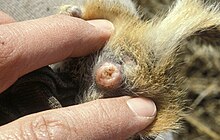
Promiscuity, in which both males and females mate with multiple partners, also occurs in rodents. In species such as the white-footed mouse, females give birth to litters with multiple paternities. Promiscuity leads to increased sperm competition and males tend to have larger testicles. In the Cape ground squirrel, the male's testes can be 20 percent of its head-body length.[67] Several rodent species have flexible mating systems that can vary between monogamy, polygyny and promiscuity.[67]
Female rodents play an active role in choosing their mates. Factors that contribute to female preference may include the size, dominance and spatial ability of the male.[68] In the eusocial naked mole rats, a single female monopolizes mating from at least three males.[38]
In most rodent species, such as brown rats and house mice, ovulation occurs on a regular cycle while in others, such as voles, it is induced by mating. During copulation, males of some rodent species deposit a mating plug in the female's genital opening, both to prevent sperm leakage and to protect against other males inseminating the female. Females can remove the plug and may do so either immediately or after several hours.[68]
Birth and parenting

Rodents may be born either
In precocial species, the mothers invest little in nest building and some do not build nests at all. The female gives birth standing and the young emerge behind her. Mothers of these species maintain contact with their highly mobile young with maternal contact calls. Though relatively independent and weaned within days, precocial young may continue to nurse and be groomed by their mothers. Rodent litter sizes also vary and females with smaller litters spend more time in the nest than those with larger litters.[70]

Mother rodents provide both direct parental care, such as nursing, grooming, retrieving and huddling, and indirect parenting, such as food caching, nest building and protection to their offspring.[70] In many social species, young may be cared for by individuals other than their parents, a practice known as alloparenting or cooperative breeding. This is known to occur in black-tailed prairie dogs and Belding's ground squirrels, where mothers have communal nests and nurse unrelated young along with their own. There is some question as to whether these mothers can distinguish which young are theirs. In the Patagonian mara, young are also placed in communal warrens, but mothers do not permit youngsters other than their own to nurse.[71]
Intelligence

Rodents have advanced cognitive abilities. They can quickly learn to avoid poisoned baits, which makes them difficult pests to deal with.[2] Guinea pigs can learn and remember complex pathways to food.[75] Squirrels and kangaroo rats are able to locate caches of food by spatial memory, rather than just by smell.[76][77]
Because laboratory mice (house mice) and rats (brown rats) are widely used as scientific models to further our understanding of biology, a great deal has come to be known about their cognitive capacities. Brown rats exhibit cognitive bias, where information processing is biased by whether they are in a positive or negative affective state.[78] For example, laboratory rats trained to respond to a specific tone by pressing a lever to receive a reward, and to press another lever in response to a different tone so as to avoid receiving an electric shock, are more likely to respond to an intermediate tone by choosing the reward lever if they have just been tickled (something they enjoy), indicating "a link between the directly measured positive affective state and decision making under uncertainty in an animal model."[79]
Laboratory (brown) rats may have the capacity for metacognition—to consider their own learning and then make decisions based on what they know, or do not know, as indicated by choices they make apparently trading off difficulty of tasks and expected rewards, making them the first animals other than primates known to have this capacity,[80][81] but these findings are disputed, since the rats may have been following simple operant conditioning principles,[82] or a behavioral economic model.[83] Brown rats use social learning in a wide range of situations, but perhaps especially so in acquiring food preferences.[84][85]
Classification and evolution
Evolutionary history
Dentition is the key feature by which fossil rodents are recognized and the earliest record of such mammals comes from the Paleocene, shortly after the extinction of the non-avian dinosaurs some 66 million years ago. These fossils are found in Laurasia,[86] the supercontinent composed of modern-day North America, Europe, and Asia. The divergence of Glires, a clade consisting of rodents and lagomorphs (rabbits, hares and pikas), from other placental mammals occurred within a few million years after the Cretaceous-Paleogene boundary; rodents and lagomorphs then radiated during the Cenozoic.[87] Some molecular clock data suggest modern rodents (members of the order Rodentia) had appeared by the late Cretaceous,[88] although other molecular divergence estimations are in agreement with the fossil record.[89][90]
Rodents are thought to have evolved in Asia, where local multituberculate faunas were severely affected by the Cretaceous–Paleogene extinction event and never fully recovered, unlike their North American and European relatives. In the resulting ecological vacuum, rodents and other Glires were able to evolve and diversify, taking the niches left by extinct multituberculates. The correlation between the spread of rodents and the demise of multituberculates is a controversial topic, not fully resolved. American and European multituberculate assemblages do decline in diversity in correlation with the introduction of rodents in these areas, but the remaining Asian multituberculates co-existed with rodents with no observable replacement taking place, and ultimately both clades co-existed for at least 15 million years.[91]
The history of the colonization of the world's continents by rodents is complex. The movements of the large superfamily Muroidea (including hamsters, gerbils, true mice and rats) may have involved up to seven colonizations of Africa, five of North America, four of Southeast Asia, two of South America and up to ten of Eurasia.[92]
During the
Nesomyid rodents are thought to have rafted from Africa to Madagascar 20–24 million years ago.[98] All 27 species of native Malagasy rodents appear to be descendants of a single colonization event.
By 20 million years ago, fossils recognizably belonging to the current families such as Muridae had emerged.
The first rodents arrived in Australia via Indonesia around 5 million years ago. Although marsupials are the most prominent mammals in Australia, many rodents, all belonging to the subfamily Murinae, are among the continent's mammal species.[102] There are about fifty species of 'old endemics', the first wave of rodents to colonize the country in the Miocene and early Pliocene, and eight true rat (Rattus) species of 'new endemics', arriving in a subsequent wave in the late Pliocene or early Pleistocene. The earliest fossil rodents in Australia have a maximum age of 4.5 million years,[103] and molecular data is consistent with the colonization of New Guinea from the west during the late Miocene or early Pliocene followed by rapid diversification. A further wave of adaptive radiation occurred after one or more colonizations of Australia some 2 to 3 million years later.[104]
Rodents participated in the Great American Interchange that resulted from the joining of the Americas by formation of the Isthmus of Panama, around 3 million years ago in the Piacenzian age.[105] In this exchange, a small number of species such as the New World porcupines (Erethizontidae) headed north.[86] However, the main southward invasion of sigmodontines preceded formation of the land bridge by at least several million years, probably occurring via rafting.[106][107][108] Sigmodontines diversified explosively once in South America, although some degree of diversification may have already occurred in Central America before the colonization.[107][108]
Standard classification
The use of the order name "Rodentia" is attributed to the English traveler and naturalist Thomas Edward Bowdich (1821).[109] The Modern Latin word Rodentia is derived from rodens, present participle of rodere – "to gnaw", "eat away".[110] The hares, rabbits and pikas (order Lagomorpha) have continuously growing incisors, as do rodents, and were at one time included in the order. However, they have an additional pair of incisors in the upper jaw and the two orders have quite separate evolutionary histories.[111] The phylogeny of the rodents places them in the clades Glires, Euarchontoglires and Boreoeutheria. The cladogram below shows the inner and outer relations of Rodentia based on a 2012 attempt by Wu et al. to align the molecular clock with paleontological data:[112]
| Boreoeutheria |
| ||||||||||||||||||||||||||||||||||||||||||||||||||||||||||||||||||||||||||||||||||||
The living rodent families based on the study done by Fabre et al. 2012.[113]
| Rodentia classification | |||||||||||||||||||||||||||||||||||||||||||||||||||||||||||||||||||||||||||||||||||||||||||||||||||||||||||||||||||||||||||||||||||||||||||||
|---|---|---|---|---|---|---|---|---|---|---|---|---|---|---|---|---|---|---|---|---|---|---|---|---|---|---|---|---|---|---|---|---|---|---|---|---|---|---|---|---|---|---|---|---|---|---|---|---|---|---|---|---|---|---|---|---|---|---|---|---|---|---|---|---|---|---|---|---|---|---|---|---|---|---|---|---|---|---|---|---|---|---|---|---|---|---|---|---|---|---|---|---|---|---|---|---|---|---|---|---|---|---|---|---|---|---|---|---|---|---|---|---|---|---|---|---|---|---|---|---|---|---|---|---|---|---|---|---|---|---|---|---|---|---|---|---|---|---|---|---|---|
|
The order Rodentia may be divided into
These disagreements remain unresolved, nor have molecular studies fully resolved the situation though they have confirmed the monophyly of the group and that the clade has descended from a common Paleocene ancestor. Carleton and Musser (2005) in Mammal Species of the World have provisionally adopted a five suborder system: Sciuromorpha, Castorimorpha, Myomorpha, Anomaluromorpha, and Hystricomorpha. As of 2021 the American Society of Mammalogists recognizes 34 recent families containing more than 481 genera and 2277 species.[116][117][118]

Order Rodentia (from Latin, rodere, to gnaw)
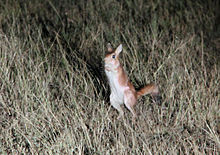



- Suborder Anomaluromorpha
- Family Anomaluridae: scaly-tailed squirrels
- Family Pedetidae: springhares
- Family Zenkerellidae: Cameroon scaly-tail
- Family
- Suborder Castorimorpha
- Superfamily Castoroidea
- Family Castoridae: beavers
- Superfamily Geomyoidea
- Family Geomyidae: pocket gophers (true gophers)
- Family Heteromyidae: kangaroo rats, kangaroo mice
- Family
- Superfamily
- Suborder Hystricomorpha
- Infraorder Ctenodactylomorphi
- Family Ctenodactylidae: gundis
- Family Diatomyidae: Laotian rock rat
- Family
- Infraorder Hystricognathi
- Parvorder Phiomorpha
- Family Bathyergidae: African mole rats
- Family Heterocephalidae: naked mole-rat
- Family Hystricidae: Old World porcupines
- Family Petromuridae: dassie rat
- Family Thryonomyidae: cane rats
- Family
- Parvorder Caviomorpha
- Superfamily Erethizontoidea
- Family Erethizontidae: New World porcupines
- Family
- Superfamily Chinchilloidea
- Family Chinchillidae: chinchillas, viscachas
- Family Dinomyidae: pacaranas
- Superfamily Cavioidea
- Family Caviidae: cavies, including guinea pigs and the capybara
- Family Dasyproctidae: agoutis
- Family Cuniculidae: pacas
- Superfamily Octodontoidea
- Family Abrocomidae: chinchilla rats
- Family Ctenomyidae: tuco-tucos
- Family Echimyidae: spiny rats, hutias, and nutria
- Family Octodontidae: octodonts
- Family
- Superfamily Erethizontoidea
- Infraorder Ctenodactylomorphi
- Suborder Myomorpha
- Superfamily Dipodoidea
- Family Dipodidae: jerboas
- Family Sminthidae: birch mice
- Family Zapodidae: jumping mice
- Family
- Superfamily Muroidea
- Family Calomyscidae: mouse-like hamsters
- Family Cricetidae: hamsters, New World rats and mice, muskrats, voles, lemmings
- Family crested rat
- Family Nesomyidae: climbing mice, rock mice, white-tailed rat, Malagasy rats and mice
- Family Platacanthomyidae: spiny dormice
- Family Spalacidae: mole rats, bamboo rats, zokors
- Family
- Superfamily Dipodoidea
- Suborder Sciuromorpha
- Family Aplodontiidae: mountain beaver
- Family Gliridae(also Myoxidae, Muscardinidae): dormice
- Family
Interaction with humans
Conservation

While rodents are not the most seriously threatened order of mammals, there are 168 species in 126 genera that are said to warrant conservation attention
The "three now cosmopolitan commensal rodent pest species"
Rodents have also been susceptible to climate change, especially species living on low-lying islands. The Bramble Cay melomys, which lived in the northernmost point of land of Australia, was the first mammal species to be declared extinct as a consequence of human-caused climate change.[127]
Exploitation
Fur
Humanity has long used animal skins for clothing, as the leather is durable and the
Consumption
At least 89 species of rodent, mostly Hystricomorpha such as guinea pigs, agoutis and capybaras, are eaten by humans; in 1985, there were at least 42 different societies in which people eat rats.[132] Guinea pigs were first raised for food around 2500 B.C. and by 1500 B.C. had become the main source of meat for the Inca Empire. Dormice were raised by the Romans in special pots called "gliraria", or in large outdoor enclosures, where they were fattened on walnuts, chestnuts, and acorns. The dormice were also caught from the wild in autumn when they were fattest, and either roasted and dipped into honey or baked while stuffed with a mixture of pork, pine nuts, and other flavorings. Researchers found that in Amazonia, where large mammals were scarce, pacas and common agoutis accounted for around 40 percent of the annual game taken by the indigenous people, but in forested areas where larger mammals were abundant, these rodents constituted only about 3 percent of the take.[132]
Guinea pigs are used in the cuisine of
Animal testing

Rodents are used widely as
Rodents have sensitive olfactory abilities, which have been used by humans to detect odors or chemicals of interest.[143] The Gambian pouched rat is able to detect tuberculosis bacilli with a sensitivity of up to 86.6%, and specificity (detecting the absence of the bacilli) of over 93%; the same species has been trained to detect land mines.[144][145] Rats have been studied for possible use in hazardous situations such as in disaster zones. They can be trained to respond to commands, which may be given remotely, and even persuaded to venture into brightly lit areas, which rats usually avoid.[146][147][148]
As pets

Rodents including guinea pigs,[149] mice, rats, hamsters, gerbils, chinchillas, degus and chipmunks make convenient pets able to live in small spaces, each species with its own qualities.[150] Most are normally kept in cages of suitable sizes and have varied requirements for space and social interaction. If handled from a young age, they are usually docile and do not bite. Guinea pigs have a long lifespan and need a large cage.[75] Rats also need plenty of space and can become very tame, can learn tricks and seem to enjoy human companionship. Mice are short-lived but take up very little space. Hamsters are solitary but tend to be nocturnal. They have interesting behaviors, but unless handled regularly they may be defensive. Gerbils are not usually aggressive, rarely bite and are sociable animals that enjoy the company of humans and their own kind.[151]
As pests and disease vectors

Some rodent species are serious agricultural
Rodents are also significant vectors of disease.
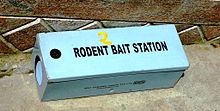
Because rodents are a nuisance and endanger
See also
- Fe, Fi, Fo, Fum, and Phooey, mice who orbited the Moon on Apollo 17
- Mouse models of breast cancer metastasis
References
- ^ Smith, Andrew T. "Lagomorph". Encyclopædia Britannica. Retrieved 31 May 2023.
- ^ ISBN 978-0-7607-1969-5.
- ^ a b c d e f Waggoner, Ben (15 August 2000). "Introduction to the Rodentia". University of California Museum of Paleontology. Archived from the original on 29 April 2009. Retrieved 4 July 2014.
- ^ ISBN 978-0-8018-5789-8.
- ISBN 978-1-84076-630-1.
- PMID 22558427.
- ^ Turnbull, William D. (1970). Mammalian masticatory apparatus. Vol. 18. [Chicago]: Field Museum Press. Archived from the original on 29 April 2022. Retrieved 11 May 2022.
- ^ S2CID 19686731.
- (PDF) from the original on 28 October 2020. Retrieved 26 August 2020.
- ^ Duckett, W. (1853). "cheek pouch". English conversation and reading. Ed Michel Levi. p. 3. Archived from the original on 5 March 2023. Retrieved 1 November 2020.
- .
- (PDF) from the original on 9 April 2009. Retrieved 26 August 2014.
- ^ "Chinchilla". Elmwood Park Zoo. Archived from the original on 30 December 2021. Retrieved 30 December 2021.
- ^ PMID 24821429.
- PMID 23593236.
- PMID 26211420.
- PMID 27450627.
- PMID 30475657.
- PMID 30724129.
- ISBN 978-0-226-90538-9.
- ISSN 1175-5326.
- (PDF) from the original on 4 September 2014. Retrieved 30 August 2014.
- ^ PMID 24130691.
- JSTOR 1937699.
- ISSN 1916-2790.
- from the original on 5 August 2020. Retrieved 7 December 2018.
- (PDF) from the original on 20 February 2014. Retrieved 4 July 2014.
- .
- ^ "Rodents...Vermin...Pests…What's The Difference?". Get Smart Rat Solutions. 1 April 2020. Archived from the original on 30 December 2021. Retrieved 30 December 2021.
- ISSN 0505-611X. Archived from the originalon 27 September 2013.
- doi:10.1644/879.1.
- ^ "Texan pocket gopher". The Mammals of Texas: Rodents. NSRL: Museum of Texas Tech University. Archived from the original on 5 October 2018. Retrieved 4 July 2014.
- ^ ISBN 978-0-563-53423-5.
- ISBN 978-0-8014-4098-4. Archivedfrom the original on 5 March 2023. Retrieved 27 January 2016.
- ^ S2CID 30382320.
- ^ "Hydromys chrysogaster: Water rat". Water for a healthy country. CSIRO. 30 June 2004. Archived from the original on 21 May 2014. Retrieved 4 July 2014.
- ^ "Northern grasshopper mouse". The Mammals of Texas: Rodents. NSRL: Museum of Texas Tech University. Archived from the original on 21 October 2020. Retrieved 4 July 2014.
- ^ PMID 7209555.
- ^ ISBN 978-0-226-35118-6.
- JSTOR 1376874.
- ISBN 978-0-8018-7416-1.
- ^ Hanson, Anne (25 October 2006). "Wild Norway rat behavior". Rat behavior and biology. Archived from the original on 1 October 2014. Retrieved 1 July 2014.
- S2CID 4333114. Archived from the original(PDF) on 14 July 2014.
- ISBN 978-0-8018-7416-1.
- doi:10.1644/756.
- PMID 18565582.
- ISBN 978-0-226-90538-9.
- ^ a b Sherwin, C.M. (2002). "Comfortable quarters for mice in research institutions". In Viktor and Annie Reinhardt (ed.). Comfortable Quarters For Laboratory Animals (9 ed.). Animal Welfare Institute. Archived from the original on 6 October 2014.
- S2CID 53160345.
- S2CID 86280677.
- .
- S2CID 13178244. Archived from the original(PDF) on 7 October 2018. Retrieved 2 July 2014.
- ISBN 978-0-19-164489-4.
- S2CID 84503870.
- S2CID 84569309.
- S2CID 84012458.
- S2CID 14063615.
- PMID 15930394.
- ^ Hanson, Anne. "What do rats see?". Rat behavior and biology. Archived from the original on 24 September 2014. Retrieved 1 July 2014.
- ^ Pickrell, John (8 July 2003). "Urine vision? How rodents communicate with UV light". National Geographic News. Archived from the original on 13 March 2014. Retrieved 8 July 2014.
- S2CID 44346136.
- S2CID 4356193.
- ^ a b c "Vibrational communication in mammals". Map of Life: Convergent evolution online. University of Cambridge. 4 August 2010. Archived from the original on 14 July 2014. Retrieved 5 July 2014.
- .
- .
- S2CID 22600955.
- ^ ISBN 978-0-226-90538-9.
- ^ ISBN 978-0-226-90538-9.
- S2CID 52984435.
- ^ ISBN 978-0-226-90538-9.
- ISBN 978-0-226-90538-9.
- ^ ISBN 978-0-226-90538-9.
- S2CID 23653101.
- S2CID 53218701.
- ^ a b Charters, Jessie Blount Allen (1904). "The associative processes of the guinea pig: A study of the psychical development of an animal with a nervous system well medullated at birth". Journal of Comparative Neurology and Psychology. XIV (4): 300–337. Archived from the original on 5 March 2023. Retrieved 1 November 2020.
- S2CID 50448069. Archived from the original(PDF) on 28 July 2020. Retrieved 13 August 2014.
- S2CID 14173113. Archived from the original(PDF) on 26 August 2014.
- S2CID 4411418.
- PMID 23300582.
- ^ Carlyle, Kim (8 March 2007). "Rats capable of reflecting on mental processes". University of Georgia. Archived from the original on 6 October 2014. Retrieved 13 August 2014.
- PMID 17346969.
- PMID 18792496.
- .
- ^ Hanson, Anne (2012). "How do rats choose what to eat?". Rat behavior and biology. Archived from the original on 7 December 2014. Retrieved 24 August 2014.
- .
- ^ PMID 18492466.
- S2CID 42090505.)
{{cite journal}}: CS1 maint: numeric names: authors list (link - from the original on 6 April 2022. Retrieved 6 April 2022.
- S2CID 23887665.
- PMID 17288612.
- ^ Wood, D. Joseph (2010). The Extinction of the Multituberculates Outside North America: a Global Approach to Testing the Competition Model (M.S.). The Ohio State University. Archived from the original on 8 April 2015. Retrieved 6 April 2015.
- PMID 23925508.
- PMID 16087426.
- (PDF) from the original on 24 December 2013. Retrieved 29 June 2014.
- ^ from the original on 12 August 2014. Retrieved 29 June 2014.
- .
- S2CID 140178414.
- S2CID 4333977.
- ^ Vekua, A.; Bendukidze, O.; Bukhsianidze, M.; Vanishvili, N.; Augusti, J.; Martinez-Navarro, B.; Rook, L. (2010). "Porcupine in the Late Neogene and Quaternary of Georgia" (PDF). Bulletin of the Georgian National Academy of Sciences. 4 (3): 140–149. Archived from the original (PDF) on 16 July 2014.
- ^ "Giant beaver". Natural History Notebooks. Canadian Museum of Nature. 28 May 2013. Archived from the original on 26 January 2021. Retrieved 19 October 2014.
- PMID 18198140.
- ISBN 978-0-643-09166-5. Archived(PDF) from the original on 24 September 2015. Retrieved 29 June 2014.
- ^ "The Action Plan for Australian Rodents". Environment Australia. 1 April 1995. Archived from the original on 7 October 2014. Retrieved 18 September 2014.
- PMID 18313945.
- ^ Baskin, Jon A.; Thomas, Ronny G. (2007). "South Texas and the Great American Interchange" (PDF). Gulf Coast Association of Geological Societies Transactions. 57: 37–45. Archived from the original (PDF) on 18 July 2014.
- S2CID 8625188.
- ^ S2CID 22355532.
- ^ PMID 23257216.
- ^ Steppan, Scott J. (18 April 2006). "Rodentia". Tree of Life Web Project. Archived from the original on 17 July 2014. Retrieved 14 July 2014.
- ^ "rodent (n.)". Online Etymology Dictionary. Archived from the original on 18 May 2015. Retrieved 7 May 2015.
- ^ Smith, Andrew T. "Lagomorph". Encyclopædia Britannica. Archived from the original on 12 August 2014. Retrieved 11 August 2014.
- PMID 23071573.
- PMID 22697210.
- ^ JSTOR 1375874.
- JSTOR 2411716.
- ISBN 978-0-8018-8221-0.
- ^ Honeycutt, Rodney L. (2009). "Rodents (Rodentia)" (PDF). In Hedges, S.B.; Kumar, S. (eds.). The Timetree of Life. Oxford University Press. Archived (PDF) from the original on 23 September 2013. Retrieved 29 September 2014.
- from the original on 22 August 2021, retrieved 9 October 2021
- ^ a b Amori, G.; Gippoliti, S. (2003). "A higher-taxon approach to rodent conservation priorities for the 21st century". Animal Biodiversity and Conservation. 26 (2): 1–18. Archived from the original on 14 July 2014. Retrieved 27 June 2014.
- ISBN 978-0-8137-1182-9.
- ^ "Rodent Conservation Assessment". WAZA. Archived from the original on 15 July 2014. Retrieved 27 June 2014.
- ^ Gudynas, Eduardo (1989). Lidicker, William Zander (ed.). Rodents: A World Survey of Species of Conservation Concern: Based on the Proceedings of a Workshop of the IUCN/SSC Rodent Specialist Group, Held at the Fourth International Theriological Congress, August 17, 1985, Edmonton, Alberta, Canada. IUCN. p. 23.
- ^ a b Buckle, A. P.; Fenn, M. G. P. (1992). "Rodent Control in the Conservation of Endangered Species". Proceedings of the 15th Vertebrate Pest Conference: Paper 12. Archived from the original on 22 July 2014. Retrieved 27 June 2014. 3–5 March 1992
- doi:10.1071/mu940001.
- ^ "Lundy puffins back from the brink". BBC Devon. 22 February 2008. Archived from the original on 24 September 2015. Retrieved 30 June 2014.
- ^ Mitchell, Heather (27 May 2014). "Puffins a-plenty? New hope for Lundy and other UK seabird islands". RSPB. Archived from the original on 16 July 2014. Retrieved 30 June 2014.
- ^ Slezak, Michael (14 June 2016). "Revealed: first mammal species wiped out by human-induced climate change". The Guardian. London. Archived from the original on 14 June 2016. Retrieved 8 December 2020.
- ^ Feinstein, Kelly (1 March 2006). "Felting a beaver hat". Fashionable Felted Fur. UC Santa Cruz. Archived from the original on 6 October 2014. Retrieved 24 September 2014.
- ISBN 978-0-8020-8196-4.
- ^ a b "Excessive trade: Clothes and trimming". Granby Zoo. May 2010. Archived from the original on 10 August 2014. Retrieved 9 August 2014.
- ^ "Lakota Quillwork Art and Legend". Akta Lakota Museum and Cultural Center. Archived from the original on 20 March 2014. Retrieved 29 June 2013.
- ^ a b c d Fiedler, Lynwood A. (1990). "Rodents as a Food Source". Proceedings of the Fourteenth Vertebrate Pest Conference 1990: 149–155. Archived from the original on 11 January 2020. Retrieved 8 July 2014.
- ^ Knowlton, David (13 July 2011). "Guinea Pig, Pet or Festive Meal". Cuzco Eats. Archived from the original on 14 July 2014. Retrieved 5 July 2014.
- ^ Morveli, Walter Coraza; Knowlton, David (5 March 2012). "Traditional Mud Stoves and Ovens Make the Best Food". Cuzco Eats. Archived from the original on 15 July 2014. Retrieved 6 July 2014.
- ISBN 978-0-226-90538-9.
- ISBN 978-0-12-426400-7.
- ISBN 978-0-323-15606-6.
- ^ ISBN 978-0-8247-5407-5.
- ISBN 978-0-683-03919-1.
- ISBN 978-0-8018-7196-2.
- ^ Gray, Tara (1998). "A Brief History of Animals in Space". National Aeronautics and Space Administration. Archived from the original on 11 October 2004. Retrieved 5 March 2007.
- ^ Sherwin, C. M. (2010). "25: The Husbandry and Welfare of Non-traditional Laboratory Rodents". In Hubrecht, R.; Kirkwood, J. (eds.). UFAW Handbook on the Care and Management of Laboratory Animals. Wiley-Blackwell. pp. 359–369.
- ^ Wines, Michael (19 May 2004). "Gambian rodents risk death for bananas". The Age. Archived from the original on 30 September 2017. Retrieved 21 June 2014.
- ^ Mhelela, Hassan (13 September 2012). "Giant rats trained to detect land mines and tuberculosis in Africa". BBC. Archived from the original on 28 June 2014. Retrieved 27 June 2014.
- ^ Bakalar, Nicholas (3 January 2011). "Detecting Tuberculosis: No Microscopes, Just Rats". The New York Times. Archived from the original on 9 May 2015. Retrieved 23 August 2014.
- ^ Harder, Ben (1 May 2002). "Scientists "Drive" rats by remote control". National Geographic. Archived from the original on 6 September 2013. Retrieved 9 November 2013.
- ^ Solon, O. (9 September 2013). "Man's mission to build remote control systems for dogs, roaches and sharks". Wired. Archived from the original on 4 November 2013. Retrieved 9 December 2013.
- S2CID 10823.
- ^ "Guinea pigs". RSPCA. 2014. Archived from the original on 14 June 2014. Retrieved 21 June 2014.
- ^ "Pet Rodents". RSPCA. 2014. Archived from the original on 14 June 2014. Retrieved 21 June 2014.
- ISBN 978-0-516-01679-5.
- PMID 19206089.
- ^ JSTOR 3868189.
- ^ S2CID 205694138.
- S2CID 128567627. Archived from the original(PDF) on 22 February 2015.
- ^ "Rodent-borne diseases". European Centre for Disease Prevention and Control. Archived from the original on 3 September 2014. Retrieved 1 September 2014.
- ^ "Diseases indirectly transmitted by rodents". Centers for Disease Control and Prevention. 2012. Archived from the original on 18 August 2014. Retrieved 1 September 2014.
- ^ Centers for Disease Control and Prevention (2006). Integrated pest management: conducting urban rodent surveys (PDF). Atlanta: US Department of Health and Human Services. Archived (PDF) from the original on 20 July 2017. Retrieved 11 September 2017.
- PMID 4587482.
- ^ "Rodent control in agriculture – an HGCA guide". Agriculture and Horticulture Development Board. 2012. Archived from the original on 25 April 2019. Retrieved 24 February 2018.
Further reading
- McKenna, Malcolm C.; Bell, Susan K. (1997). Classification of Mammals Above the Species Level. Columbia University Press. ISBN 978-0-231-11013-6.
- Wilson, D. E.; Reeder, D. M., eds. (2005). Mammal Species of the World: A Taxonomic and Geographic Reference. Johns Hopkins University Press. ISBN 978-0-8018-8221-0.
- Carleton, M. D.; Musser, G. G. "Order Rodentia", pages 745–752 in Wilson & Reeder (2005).
External links
Zoology, osteology, comparative anatomy
- ArchéoZooThèque : Rodent osteology Archived 29 January 2015 at the Wayback Machine (photos)
- ArchéoZooThèque : Rodent skeleton drawings
Various
- African rodentia
- Rodent photos on Flickr
- Rodent Species Fact Sheets from the National Pest Management Association on Deer Mice, Norway Rats, and other rodent species

